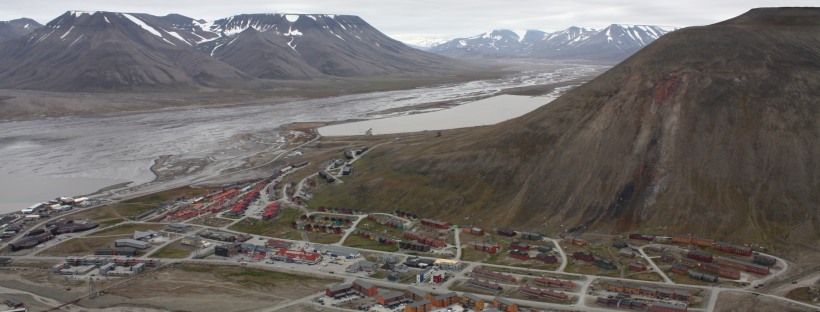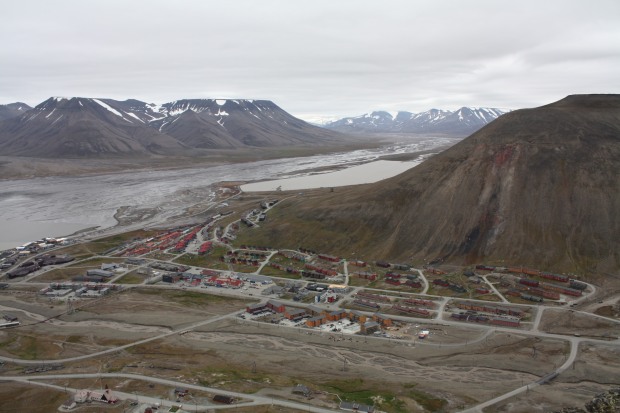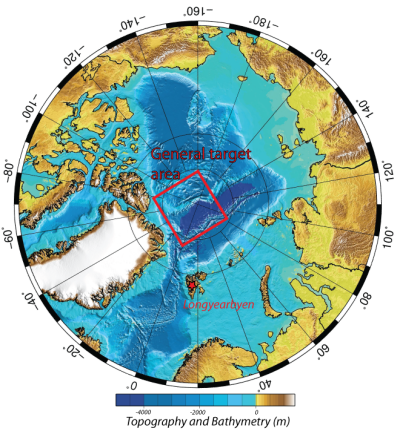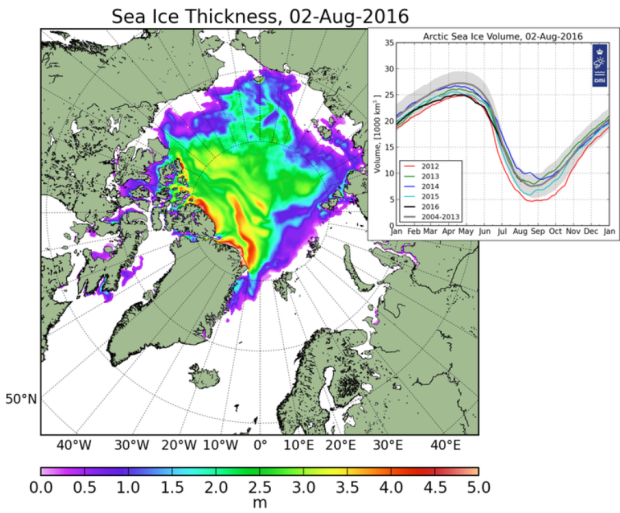This is the second Arctic Ocean blog (following the Overview post) and explains a little more about where we are heading and the type of features we are targeting.
The seafloor, with its underlying sediments and rocks, is not as boring as it may seem. The Arctic Ocean may be the world’s smallest ocean but by no means does that translate to a simple evolutionary history – it is commonly said that we understand more about the surface of Mars than we do about our ocean floors. The Arctic Ocean is surrounded by shallow and largely flat continental shelves, and has a deep and undulating interior. It is in this central area where many aspects of geology and oceanography become particularly exciting, and where we are heading on Oden.
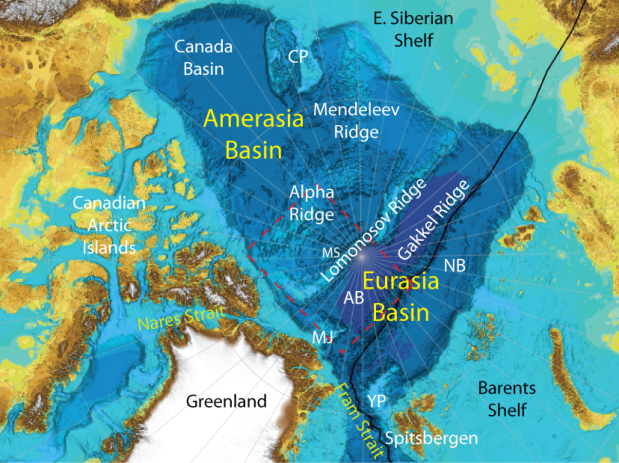
Figure: Overview of the Arctic Ocean topography and bathymetry (IBCAO) with major features labelled: AB Amundsen Basin, CP Chukchi Plateau, MJ Morris Jesup Rise, MS Marvin Spur, NB Nansen Basin, YP Yermak Plateau. The Lomonosov Ridge separates the two major basins of different ages and red box shows the general area of the cruise sampling sites.
The Arctic Ocean today is the culmination of a long history of horizontal and vertical plate motions; there have been plate collisions leading to mountain building events and/or subduction events where some rocks are pushed deep into the mantle, rifting between plates and the opening of new ocean basins, changes in sea-level, periods of glacial or greenhouse conditions as well as volcanism on massive and localized scales. The dynamic and intrinsic interplay between the geosphere, biosphere, atmosphere and hydrosphere is particularly pertinent in understanding the evolution of the Arctic. The sedimentary record (or “stratigraphic record”) can tell us a lot about the many geologic and oceanographic processes that have occurred within the Arctic – at least as far back in time as we can retrieve from the samples.
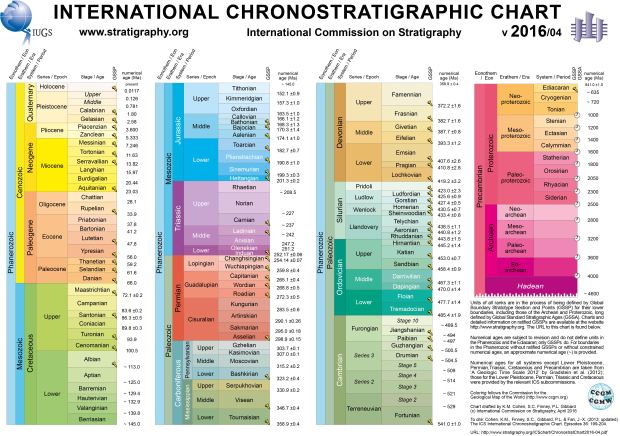
Figure: International chronostratigraphic chart (time, basically) which shows the names of the time periods we refer to, as well as their absolute ages – geoscientists often switch between names and numerical ages. On this cruise we will be looking at sediments from the first column, especially the last Quaternary period and hopefully the Cretaceous. Figure from the ICS webpage.
The Arctic Ocean consists of two major ocean basins; the Eurasia Basin in the eastern domain and the Amerasia Basin in the western domain. The long, thin Lomonosov Ridge separates the two basins which are of significantly different age. The opening of the long, linear Eurasia Basin is relatively well understood – spreading occurred around 55 million years ago (‘Ma’ or ‘Myrs ago’) along the Gakkel mid-oceanic ridge and is continuing today at a very slow rate of around 1 cm/yr. By contrast, the Amerasia Basin is thought to have opened over 100 million years ago and the style and timing of opening is hotly debated in the geoscience community. Part of this complication is related to several large bathymetric features of uncertain origins – some features are thought to include continental rocks, others oceanic rocks, and others a kind of transitional type or related to massive volcanism. In addition to physical sampling including coring, dredging and heatflow measurements, other methods to investigate the sub-surface structure of the region include gravity and magnetic measurements, as well as seismic waves and acoustic sound data.
GIF below: Simplified plate reconstruction (fixed Eurasia for reference) running from 160 million years ago to present-day showing the rotation and opening of the Amerasia Basin between 160-120 Ma followed by the Eurasia Basin from 55-0 Ma. You can also see some rifting and spreading between Greenland and North America and Greenland and Eurasia. Present-day topography is reconstructed and plate boundaries are in black. Base reconstruction is from Shephard et al. (2013; Earth Sci Reviews) and is visualized in the freely available software GPlates.
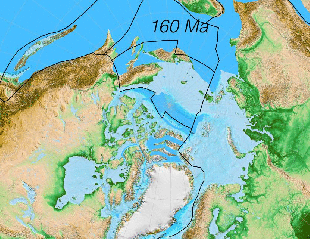
Below I summarize a few key structural features from the central Arctic relevant for the cruise. These features have variable rock types and ages as well as different thicknesses and ages of the overlying sediments. Generally speaking, some of the sediments are nice and flat, capturing a near continuous record of time, and are referred to as “conformable.” Other sites may have been disturbed by ice, water currents, have slumped down from a slope or been uplifted and exposed to sub-aerial erosion, and/or have been disturbed by tectonic motions through time. On the cruise we aim to sample sediments of all ages from within the basin, and I am particularly interested in as old as possible.
Lomonosov Ridge: Slither of continental rock that rifted from the edge of Eurasia (e.g. the Barents Shelf) with the opening of the Eurasia Basin around 55 Myrs ago. There have been a number of expeditions to sample this feature including sedimentary coring samples and the only deep sea-drilling core ACEX. Both Russia and Denmark (Canada is yet to resubmit…) have submitted claims under UNCLOS covering parts of this ridge.
Alpha-Mendeleev Ridge: An extensive feature that broadly stretches from north of the Canadian Arctic Islands to the Russian shelf. Proposed to be part of the High Arctic Large Igneous Province that erupted around 120-90 Myrs ago. Whether the Alpha and/or the Mendeleev Ridge(s) includes, or is underlain by, continental or oceanic rocks is unclear – it is a key feature in understanding the opening of the Amerasia Basin. This is a site where we hope to recover some of the “older” sediments i.e. Cretaceous age ~ older than 66 Myrs. In particular we will re-visit some sites from the 1960-80’s T3 and CESAR expeditions.
Marvin Spur: This looks like a mini-me of the Lomonosov Ridge and might include some undisturbed sediments of Quaternary age. It is likely related to the same rifting event that opened the Eurasia Basin, even though it is located on the Amerasia Basin side of the larger Ridge.
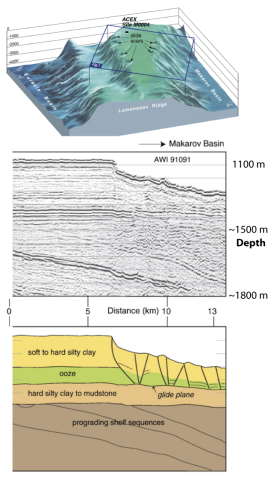 Figure (right): Figures reproduced from Kristoffersen et al. (2007; Marine Geology) showing zoom into Lomonosov Ridge (top), sample of acoustic stratigraphy (middle; from AWI-91091) and interpretation of sediment type (bottom).
Figure (right): Figures reproduced from Kristoffersen et al. (2007; Marine Geology) showing zoom into Lomonosov Ridge (top), sample of acoustic stratigraphy (middle; from AWI-91091) and interpretation of sediment type (bottom).
Canada Basin: Restricted region of the larger Amerasia Basin. Recent studies suggest that this is the only region of “true” oceanic seafloor. Prevailing models favour a counter-clockwise rotation of Alaska and parts of Russia away from Canada sometime around 140-100 Myrs ago. While we will not be sampling this area, considering the relationship between the Canada Basin and the remainder of the Amerasia Basin (especially the Alpha Ridge and the closest side of the Lomonosov Ridge) is critical for creating holistic regional models.
 05 August 2016, Oslo
05 August 2016, Oslo
References:
–Kristoffersen, Y., Coakley, B., Hall, J.K., and Edwards, M. 2007. Mass wasting on the submarine Lomonosov Ridge, central Arctic Ocean. Marine Geology v.243 p.137-142.
–Shephard, G.E., Müller, R.D., Seton, M. 2013 The tectonic evolution of the Arctic since Pangea breakup: Integrating constraints from surface geology and geophysics with mantle structure. Earth-Science Reviews 124, 148-183


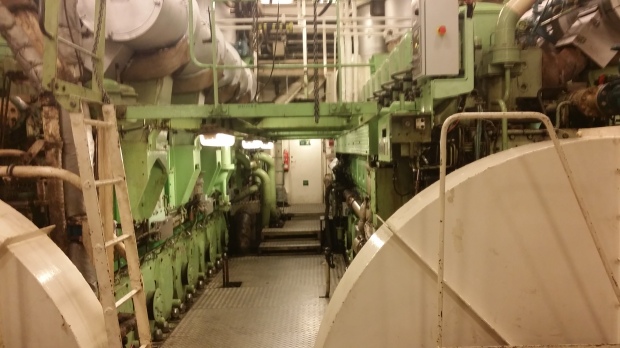





 Figure (right): Figures reproduced from Kristoffersen et al. (2007; Marine Geology) showing zoom into Lomonosov Ridge (top), sample of acoustic stratigraphy (middle; from AWI-91091) and interpretation of sediment type (bottom).
Figure (right): Figures reproduced from Kristoffersen et al. (2007; Marine Geology) showing zoom into Lomonosov Ridge (top), sample of acoustic stratigraphy (middle; from AWI-91091) and interpretation of sediment type (bottom). 05 August 2016, Oslo
05 August 2016, Oslo
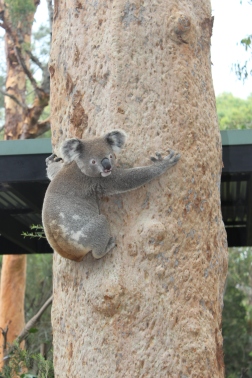 Koala
Koala
